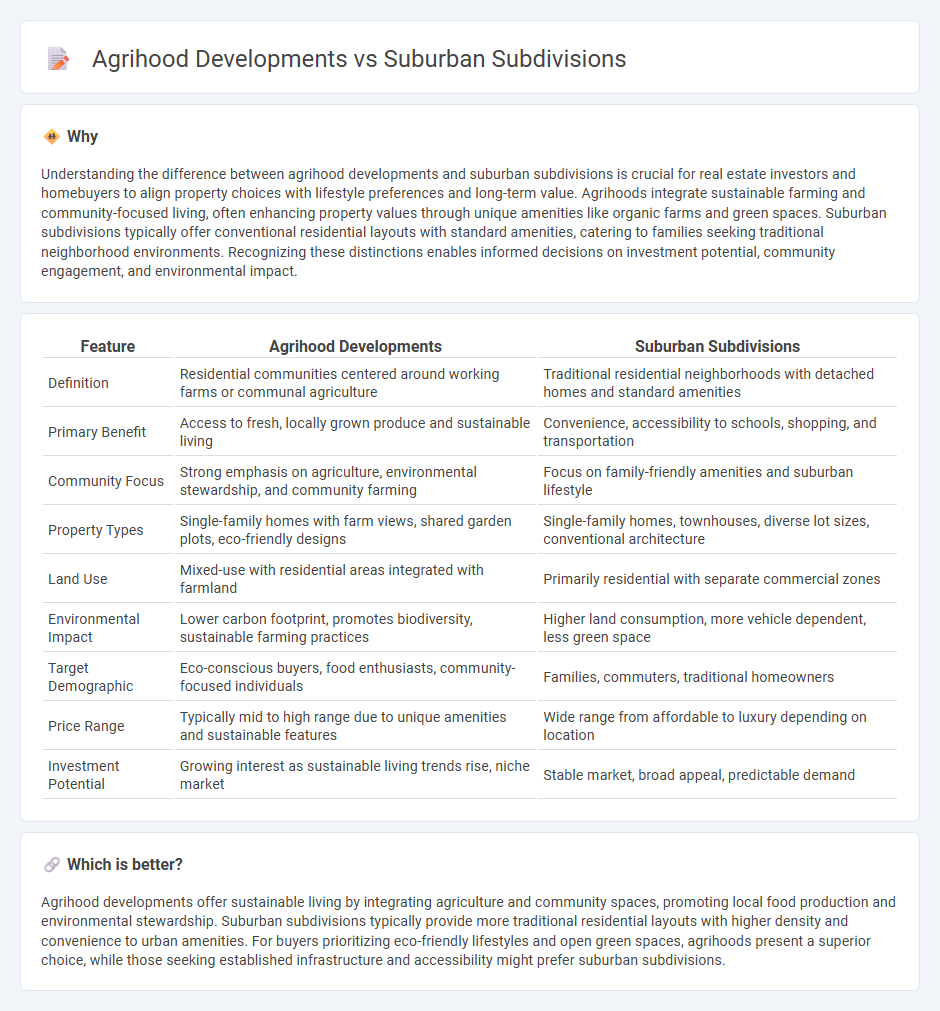
Agrihood developments integrate residential living with sustainable farming, offering community members access to fresh produce and green spaces, enhancing environmental and social benefits compared to traditional suburban subdivisions. Suburban subdivisions typically focus on dense housing and infrastructure, emphasizing convenience and standardized amenities but often lacking agricultural integration. Discover how these contrasting real estate approaches shape modern living environments and community wellness.
Why it is important
Understanding the difference between agrihood developments and suburban subdivisions is crucial for real estate investors and homebuyers to align property choices with lifestyle preferences and long-term value. Agrihoods integrate sustainable farming and community-focused living, often enhancing property values through unique amenities like organic farms and green spaces. Suburban subdivisions typically offer conventional residential layouts with standard amenities, catering to families seeking traditional neighborhood environments. Recognizing these distinctions enables informed decisions on investment potential, community engagement, and environmental impact.
Comparison Table
| Feature | Agrihood Developments | Suburban Subdivisions |
|---|---|---|
| Definition | Residential communities centered around working farms or communal agriculture | Traditional residential neighborhoods with detached homes and standard amenities |
| Primary Benefit | Access to fresh, locally grown produce and sustainable living | Convenience, accessibility to schools, shopping, and transportation |
| Community Focus | Strong emphasis on agriculture, environmental stewardship, and community farming | Focus on family-friendly amenities and suburban lifestyle |
| Property Types | Single-family homes with farm views, shared garden plots, eco-friendly designs | Single-family homes, townhouses, diverse lot sizes, conventional architecture |
| Land Use | Mixed-use with residential areas integrated with farmland | Primarily residential with separate commercial zones |
| Environmental Impact | Lower carbon footprint, promotes biodiversity, sustainable farming practices | Higher land consumption, more vehicle dependent, less green space |
| Target Demographic | Eco-conscious buyers, food enthusiasts, community-focused individuals | Families, commuters, traditional homeowners |
| Price Range | Typically mid to high range due to unique amenities and sustainable features | Wide range from affordable to luxury depending on location |
| Investment Potential | Growing interest as sustainable living trends rise, niche market | Stable market, broad appeal, predictable demand |
Which is better?
Agrihood developments offer sustainable living by integrating agriculture and community spaces, promoting local food production and environmental stewardship. Suburban subdivisions typically provide more traditional residential layouts with higher density and convenience to urban amenities. For buyers prioritizing eco-friendly lifestyles and open green spaces, agrihoods present a superior choice, while those seeking established infrastructure and accessibility might prefer suburban subdivisions.
Connection
Agrihood developments integrate agricultural elements into suburban subdivisions, fostering sustainable living by combining residential homes with community farms, gardens, and open green spaces. These communities promote local food production, enhance environmental stewardship, and attract homebuyers seeking a blend of rural charm and suburban convenience. The synergy between agrihoods and traditional subdivisions redefines neighborhood design by prioritizing ecosystem health and social engagement.
Key Terms
Zoning
Suburban subdivisions primarily feature single-family residential zoning, allowing limited commercial or agricultural use, which supports traditional neighborhood layouts with defined property lines and infrastructure. Agrihood developments integrate mixed-use zoning, combining residential spaces with active agricultural areas to encourage community farming, sustainability, and local food production. Explore the distinct zoning benefits and challenges of these development types to understand their impact on community design and land use.
Community Amenities
Suburban subdivisions typically offer standard community amenities such as playgrounds, swimming pools, and clubhouses designed to appeal to a broad residential market. Agrihood developments prioritize integrated agricultural features like community gardens, farmer's markets, and shared green spaces that foster sustainable living and local food production. Explore how each neighborhood type enhances lifestyle and social interaction by discovering their unique amenities.
Land Use
Suburban subdivisions typically prioritize residential density with uniform lots designed for single-family homes, maximizing housing units within designated zoning areas. Agrihood developments integrate agricultural land-use, combining residential living with active farmland, community gardens, or orchards to promote local food production and sustainable living. Explore the distinct land-use strategies to understand their impact on community design and environmental sustainability.
Source and External Links
Suburbs in The U.S | Definition & Examples - Lesson - Suburban subdivisions are residential neighborhoods composed mainly of single-family homes built close together on the outskirts of cities, often developed after World War II during suburbanization and characterized by community layouts that surround the city in a ring pattern called the peripheral model.
Suburb - Wikipedia - Suburban subdivisions typically arose with the rise of automobile use and highway systems, evolving from earlier streetcar suburbs, and are often medium-density residential areas that serve as living spaces in metropolitan regions, sometimes growing more populous than central cities.
What is a Suburban Neighborhood? - Apartment Guide - A suburban subdivision is a residential cluster near urban areas featuring less dense housing than cities but more development than rural areas, providing a quieter lifestyle that balances accessibility to city amenities with proximity to nature.
 dowidth.com
dowidth.com